Read Cori Lausen’s Nahanni bat report, and view the CPAWS-NWT Bat Poster celebrating the discovery of new species in the Nahanni Survey.

Cori was assisted in the Nahanni National Park bat survey by Parks Canada employees Kim Schlosser [foreground], John Waithaka [left], and Jarrett Hardisty [in the stern, taking this photo].
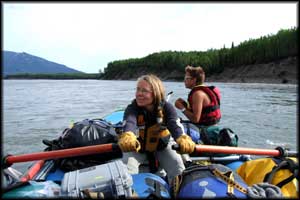
With Jarrett Hardisty at the stern, Cori takes a turn rowing on the South Nahanni, a popular white-water river in northern Canada. While doing a bat survey by canoe is possible, netting bats requires a lot of gear. A raft is often the best choice for a long bat survey, since tipping in the rapids is highly undesirable!

Cori sets a mistnet. Part of her equipment repertoire is a large selection of mistnet poles. In this location, telescoping painter’s poles are ideal for holding up nets in marshy soil. Cori chooses from 5 different types of mistnet poles to best suit the survey conditions.
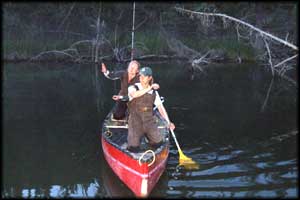
Cori makes adjustments to what appears to be empty space, but is really a mistnet. With the assistance of Kim Schlosser, they set a net across water too deep for wading. Cori has designed a floating net that can also be used when the water is too deep for chest waders.
 These photos show mistnetting strung over a pond in the Northwest Territories.
These photos show mistnetting strung over a pond in the Northwest Territories.
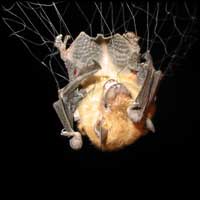
In northern Canada, the night skies stay light most of the night, making capturing bats a real challenge. Bats can see the nets when the skies are too light, so strategic placement is critical in catching bats north of 60 degrees.
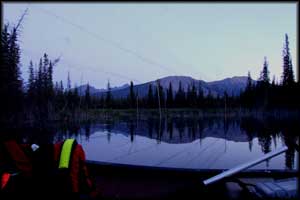 Bats are most often captured with mistnets. Using echolocation, bats are able to detect the fine mesh material. However, they are not always paying close attention! When the bat hits the net, it falls into a small pocket created by its weight, and will often chew a hole in the net and make its escape.
Bats are most often captured with mistnets. Using echolocation, bats are able to detect the fine mesh material. However, they are not always paying close attention! When the bat hits the net, it falls into a small pocket created by its weight, and will often chew a hole in the net and make its escape.
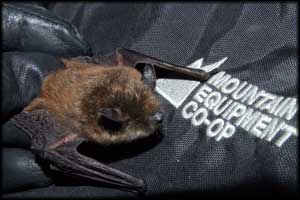 This little brown bat is the most common species of bat found in the north. Mountain Equipment Co-op assisted Parks Canada in funding Cori’s bat survey in the Nahanni River National Park Reserve in 2006. CPAWS-NWT was a funding liaison and provided tremendous support, including the production a community poster educating locals about the new species of bats found in NWT during this survey. The poster was supported by a number of other groups including Y2Y Conservation Initiative and Bat Conservation International.
This little brown bat is the most common species of bat found in the north. Mountain Equipment Co-op assisted Parks Canada in funding Cori’s bat survey in the Nahanni River National Park Reserve in 2006. CPAWS-NWT was a funding liaison and provided tremendous support, including the production a community poster educating locals about the new species of bats found in NWT during this survey. The poster was supported by a number of other groups including Y2Y Conservation Initiative and Bat Conservation International.
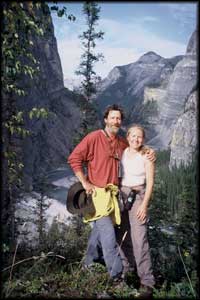 Michael and Cori at Prairie Creek, Nahanni National Park. Inspired by their recreational white-water canoe trip through the park in 2004, they proposed the first formal bat survey for the NWT. In 2006 using white-water raft, Cori surveyed bats along the South Nahanni River, more than tripling the number of bat species known for the Park, and extending the northern range of 3 species. As a husband and wife team, Cori and Michael carry out ecological wildlife research under their company, Birchdale Ecological, Inc.
Michael and Cori at Prairie Creek, Nahanni National Park. Inspired by their recreational white-water canoe trip through the park in 2004, they proposed the first formal bat survey for the NWT. In 2006 using white-water raft, Cori surveyed bats along the South Nahanni River, more than tripling the number of bat species known for the Park, and extending the northern range of 3 species. As a husband and wife team, Cori and Michael carry out ecological wildlife research under their company, Birchdale Ecological, Inc.
This bat survey was made possible by Mountain Equipment Co-Op
and Parks Canada.
